check engine Ram ProMaster 2019 Owner's Guide
[x] Cancel search | Manufacturer: RAM, Model Year: 2019, Model line: ProMaster, Model: Ram ProMaster 2019Pages: 332, PDF Size: 3.66 MB
Page 236 of 332
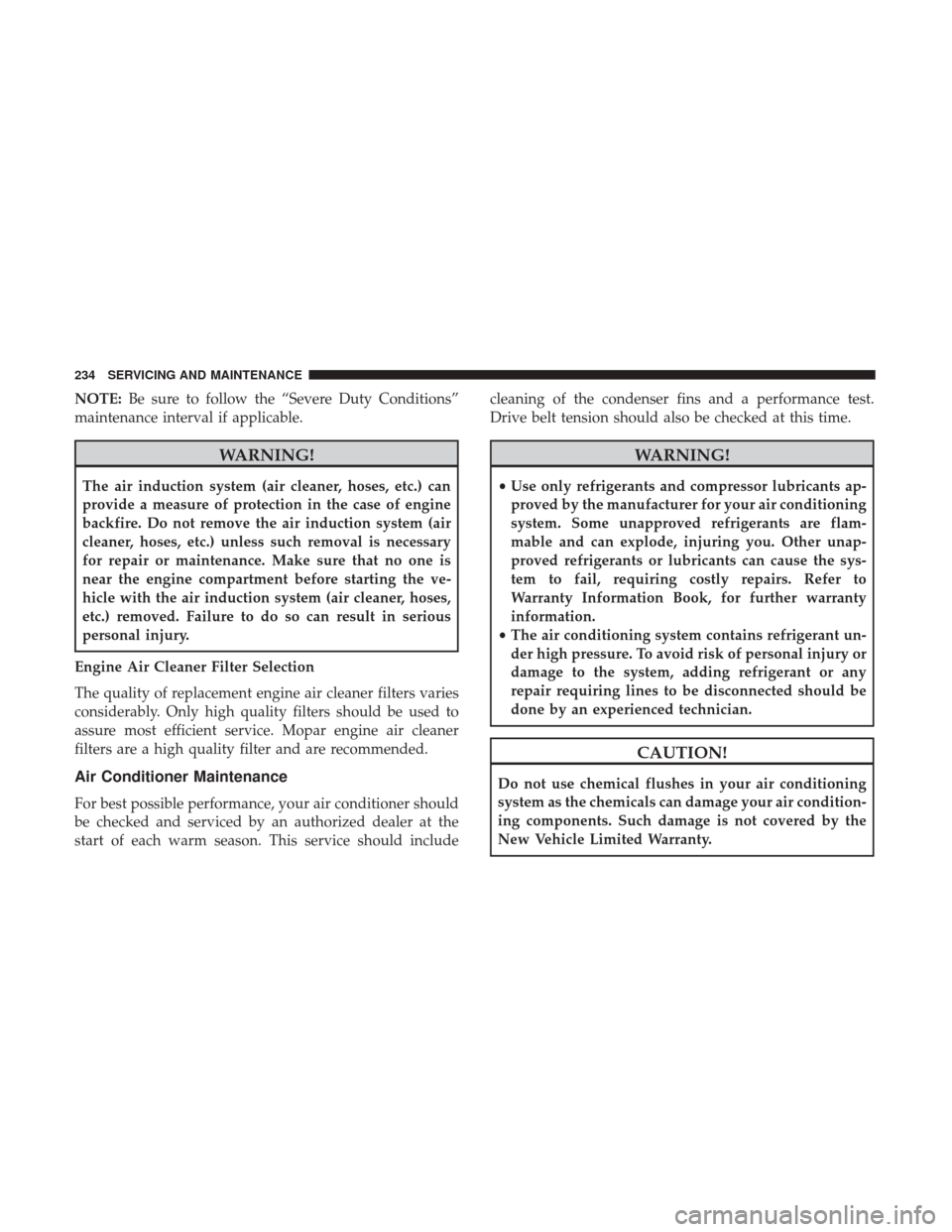
NOTE:Be sure to follow the “Severe Duty Conditions”
maintenance interval if applicable.
WARNING!
The air induction system (air cleaner, hoses, etc.) can
provide a measure of protection in the case of engine
backfire. Do not remove the air induction system (air
cleaner, hoses, etc.) unless such removal is necessary
for repair or maintenance. Make sure that no one is
near the engine compartment before starting the ve-
hicle with the air induction system (air cleaner, hoses,
etc.) removed. Failure to do so can result in serious
personal injury.
Engine Air Cleaner Filter Selection
The quality of replacement engine air cleaner filters varies
considerably. Only high quality filters should be used to
assure most efficient service. Mopar engine air cleaner
filters are a high quality filter and are recommended.
Air Conditioner Maintenance
For best possible performance, your air conditioner should
be checked and serviced by an authorized dealer at the
start of each warm season. This service should include cleaning of the condenser fins and a performance test.
Drive belt tension should also be checked at this time.
WARNING!
•
Use only refrigerants and compressor lubricants ap-
proved by the manufacturer for your air conditioning
system. Some unapproved refrigerants are flam-
mable and can explode, injuring you. Other unap-
proved refrigerants or lubricants can cause the sys-
tem to fail, requiring costly repairs. Refer to
Warranty Information Book, for further warranty
information.
• The air conditioning system contains refrigerant un-
der high pressure. To avoid risk of personal injury or
damage to the system, adding refrigerant or any
repair requiring lines to be disconnected should be
done by an experienced technician.
CAUTION!
Do not use chemical flushes in your air conditioning
system as the chemicals can damage your air condition-
ing components. Such damage is not covered by the
New Vehicle Limited Warranty.
234 SERVICING AND MAINTENANCE
Page 241 of 332

WARNING!(Continued)
do not open the hood until the radiator has had time
to cool. Never open a cooling system pressure cap
when the radiator or coolant bottle is hot.
• Keep hands, tools, clothing, and jewelry away from
the radiator cooling fan when the hood is raised. The
fan starts automatically and may start at any time,
whether the engine is running or not.
• When working near the radiator cooling fan, discon-
nect the fan motor lead or turn the ignition to the
OFF mode. The fan is temperature controlled and can
start at any time the ignition is in the ON mode.
Coolant Checks
Check the engine coolant (antifreeze) protection every 12
months (before the onset of freezing weather, where appli-
cable). If the engine coolant (antifreeze) is dirty, the system
should be drained, flushed, and refilled with fresh OAT
coolant (conforming to MS-12106) only by an authorized
dealer. Check the front of the A/C condenser for any
accumulation of bugs, leaves, etc. If dirty, clean by gently
spraying water from a garden hose vertically down the face
of the condenser.
Cooling System — Drain, Flush And Refill
NOTE: Some vehicles require special tools to add coolant
properly. Failure to fill these systems properly could lead to
severe internal engine damage. If any coolant is needed to
be added to the system please contact an authorized dealer.
If the engine coolant (antifreeze) is dirty or contains visible
sediment, have an authorized dealer clean and flush with
OAT coolant (antifreeze) (conforming to MS.90032).
Refer to the “Maintenance Plan” in this section for the
proper maintenance intervals.
Selection Of Coolant
Refer to “Fluids And Lubricants” in “Technical Specifica-
tions” for further information.
8
SERVICING AND MAINTENANCE 239
Page 244 of 332

Disposal Of Used Coolant
Used ethylene glycol-based coolant (antifreeze) is a regu-
lated substance requiring proper disposal. Check with your
local authorities to determine the disposal rules for your
community. To prevent ingestion by animals or children,
do not store ethylene glycol-based coolant in open contain-
ers or allow it to remain in puddles on the ground. If
ingested by a child or pet, seek emergency assistance
immediately. Clean up any ground spills immediately.
Coolant Level
The coolant expansion bottle provides a quick visual
method for determining that the coolant level is adequate.
With engine off and cold, the level of the engine coolant
(antifreeze) in the bottle should be between the “MIN” and
“MAX” marks.
Points To Remember
NOTE:When the vehicle is stopped after a few miles/
kilometers of operation, you may observe vapor coming
from the front of the engine compartment. This is normally
a result of moisture from rain, snow, or high humidity
accumulating on the radiator and being vaporized when
the thermostat opens, allowing hot engine coolant (anti-
freeze) to enter the radiator. If an examination of your engine compartment shows no
evidence of radiator or hose leaks, the vehicle may be
safely driven. The vapor will soon dissipate.
•
Do not overfill the coolant expansion bottle.
• Check the coolant freeze point in the radiator and in the
coolant expansion bottle. If engine coolant (antifreeze)
needs to be added, the contents of the coolant expansion
bottle must also be protected against freezing.
• If frequent engine coolant (antifreeze) additions are
required, the cooling system should be pressure tested
for leaks.
• Maintain engine coolant (antifreeze) concentration at a
minimum of 50% OAT coolant (conforming to
MS.90032) and distilled water for proper corrosion pro-
tection of your engine which contains aluminum com-
ponents.
• Make sure that the coolant expansion bottle overflow
hoses are not kinked or obstructed.
• Keep the front of the radiator clean. If your vehicle is
equipped with air conditioning, keep the front of the
condenser clean.
• Do not change the thermostat for Summer or Winter
operation. If replacement is ever necessary, install ONLY
242 SERVICING AND MAINTENANCE
Page 245 of 332
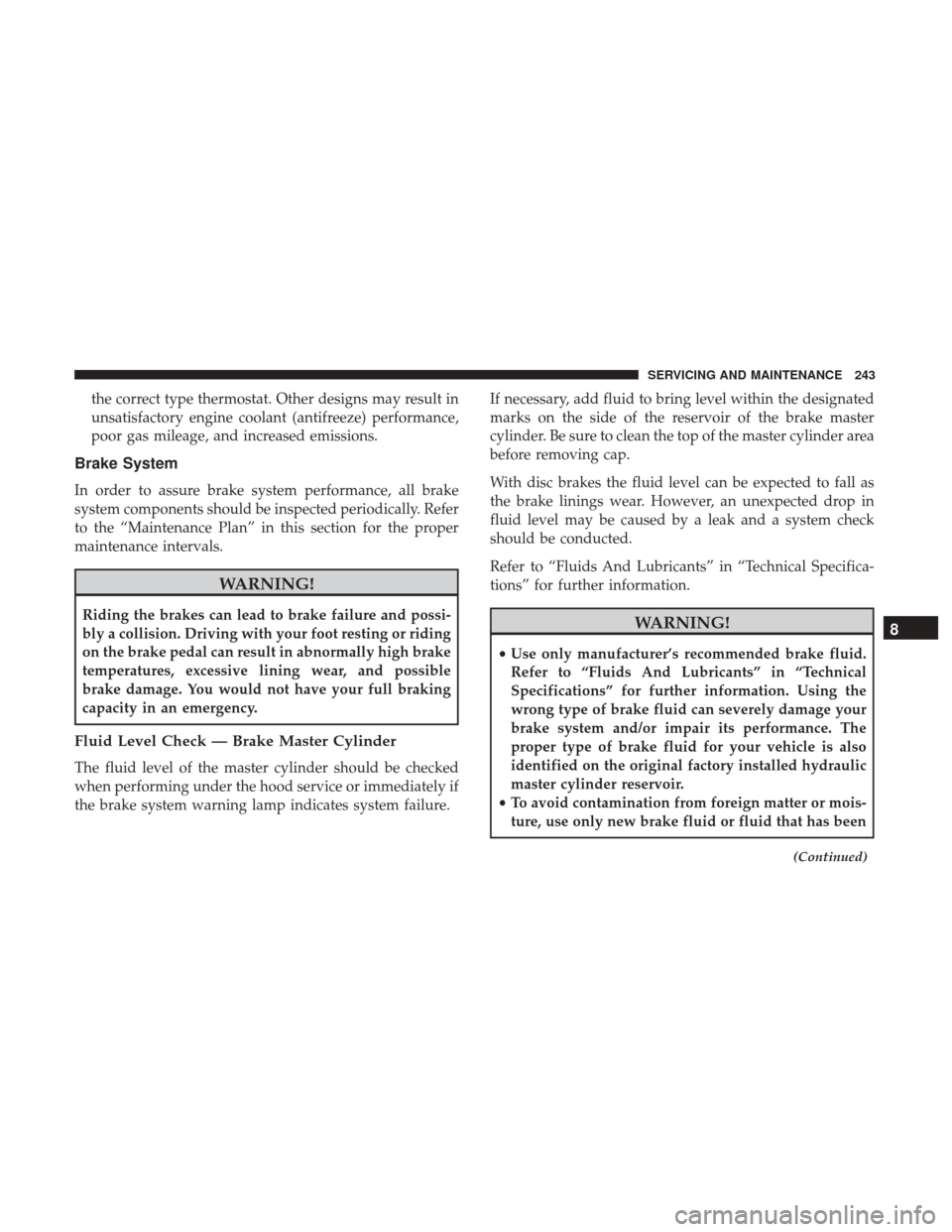
the correct type thermostat. Other designs may result in
unsatisfactory engine coolant (antifreeze) performance,
poor gas mileage, and increased emissions.
Brake System
In order to assure brake system performance, all brake
system components should be inspected periodically. Refer
to the “Maintenance Plan” in this section for the proper
maintenance intervals.
WARNING!
Riding the brakes can lead to brake failure and possi-
bly a collision. Driving with your foot resting or riding
on the brake pedal can result in abnormally high brake
temperatures, excessive lining wear, and possible
brake damage. You would not have your full braking
capacity in an emergency.
Fluid Level Check — Brake Master Cylinder
The fluid level of the master cylinder should be checked
when performing under the hood service or immediately if
the brake system warning lamp indicates system failure.If necessary, add fluid to bring level within the designated
marks on the side of the reservoir of the brake master
cylinder. Be sure to clean the top of the master cylinder area
before removing cap.
With disc brakes the fluid level can be expected to fall as
the brake linings wear. However, an unexpected drop in
fluid level may be caused by a leak and a system check
should be conducted.
Refer to “Fluids And Lubricants” in “Technical Specifica-
tions” for further information.
WARNING!
•
Use only manufacturer’s recommended brake fluid.
Refer to “Fluids And Lubricants” in “Technical
Specifications” for further information. Using the
wrong type of brake fluid can severely damage your
brake system and/or impair its performance. The
proper type of brake fluid for your vehicle is also
identified on the original factory installed hydraulic
master cylinder reservoir.
• To avoid contamination from foreign matter or mois-
ture, use only new brake fluid or fluid that has been
(Continued)
8
SERVICING AND MAINTENANCE 243
Page 318 of 332
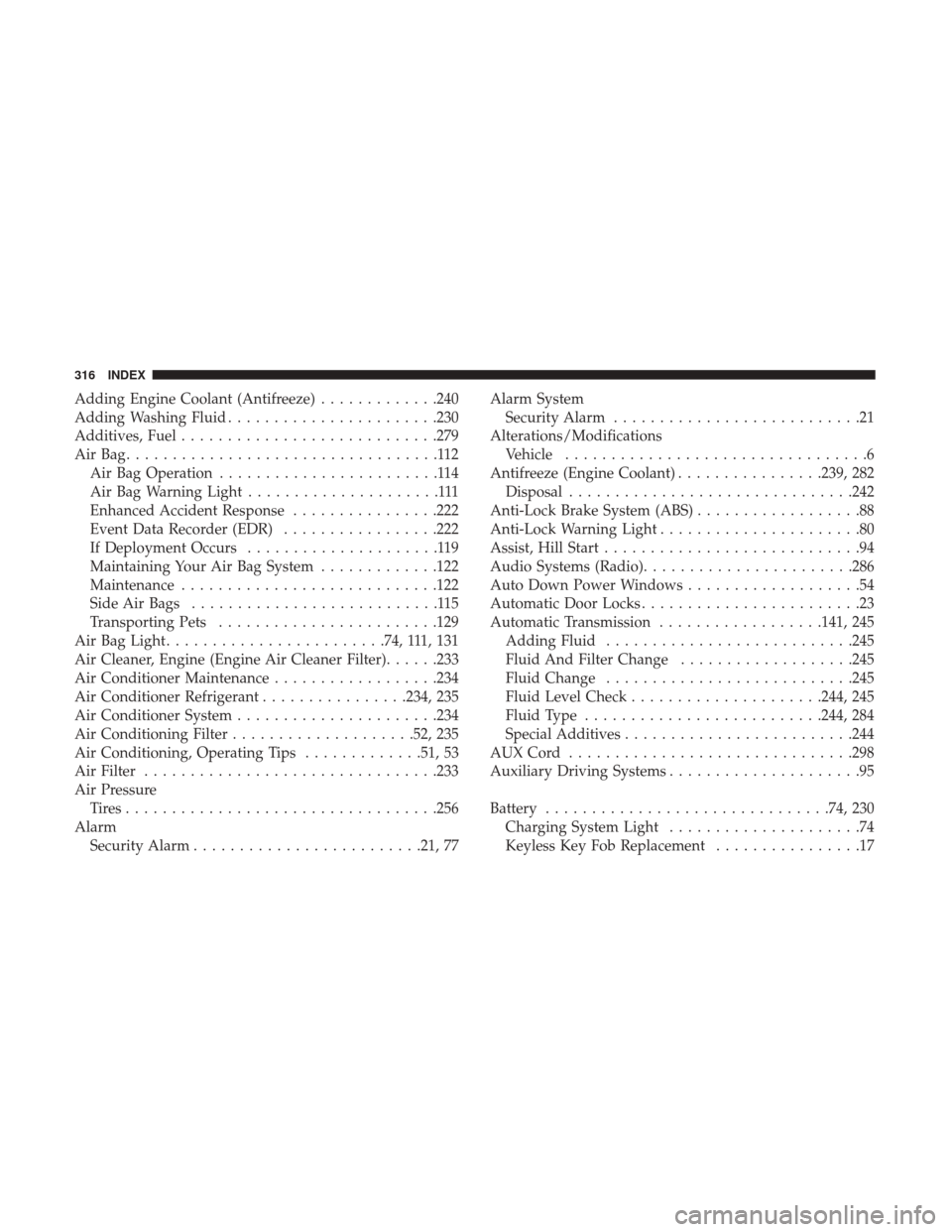
Adding Engine Coolant (Antifreeze).............240
Adding Washing Fluid ...................... .230
Additives, Fuel ........................... .279
AirBag..................................112 Air Bag Operation ........................114
Air Bag Warning Light .....................111
Enhanced Accident Response ................222
Event Data Recorder (EDR) .................222
If Deployment Occurs .....................119
Maintaining Your Air Bag System .............122
Maintenance ........................... .122
Side Air Bags ...........................115
Transporting Pets ....................... .129
Air Bag Light ....................... .74, 111, 131
Air Cleaner, Engine (Engine Air Cleaner Filter) ......233
Air Conditioner Maintenance ..................234
Air Conditioner Refrigerant ................234, 235
Air Conditioner System ..................... .234
Air Conditioning Filter ....................52, 235
Air Conditioning, Operating Tips .............51, 53
Air Filter ............................... .233
Air Pressure Tires................................. .256
Alarm Security Alarm ........................ .21, 77Alarm System
Security Alarm ...........................21
Alterations/Modifications Vehicle .................................6
Antifreeze (Engine Coolant) ................239, 282
Disposal .............................. .242
Anti-Lock Brake System (ABS) ..................88
Anti-Lock Warning Light ......................80
Assist, Hill Start ............................94
Audio Systems (Radio) ...................... .286
Auto Down Power Windows ...................54
Automatic Door Locks ........................23
Automatic Transmission ..................141, 245
Adding Fluid .......................... .245
Fluid And Filter Change ...................245
Fluid Change .......................... .245
Fluid Level Check .....................244,
245
Fluid Type ......................... .244, 284
Special Additives ........................ .244
AUXCord .............................. .298
Auxiliary Driving Systems .....................95
Battery .............................. .74, 230
Charging System Light .....................74
Keyless Key Fob Replacement ................17
316 INDEX
Page 319 of 332
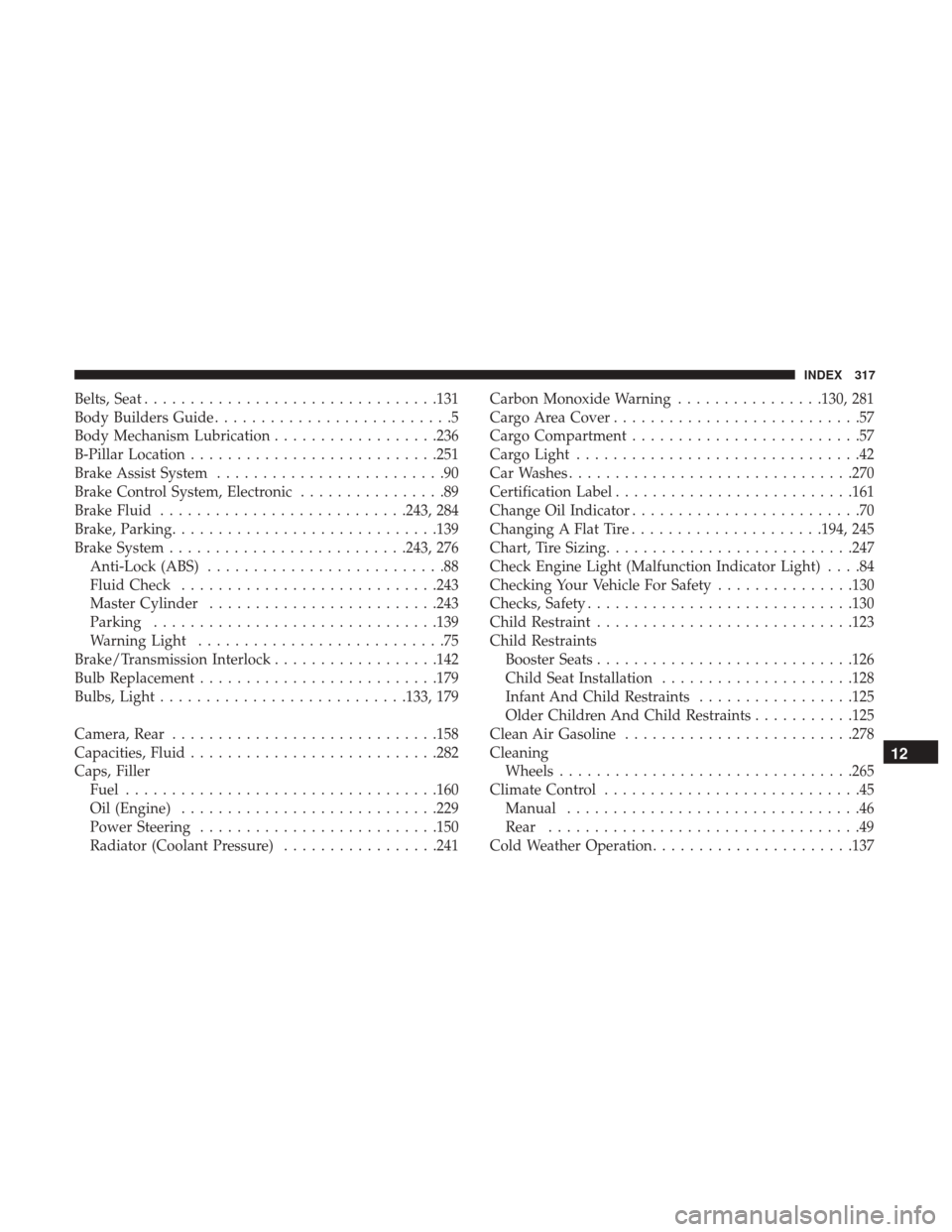
Belts, Seat............................... .131
Body Builders Guide ..........................5
Body Mechanism Lubrication ..................236
B-Pillar Location .......................... .251
Brake Assist System .........................90
Brake Control System, Electronic ................89
Brake Fluid .......................... .243, 284
Brake, Parking ............................ .139
Brake System ......................... .243, 276
Anti-Lock (ABS) ..........................88
Fluid Check ........................... .243
Master Cylinder ........................ .243
Parking .............................. .139
Warning Light ...........................75
Brake/Transmission Interlock ..................142
Bulb Replacement ......................... .179
Bulbs, Light .......................... .133, 179
Camera, Rear ............................ .158
Capacities, Fluid .......................... .282
Caps, Filler Fuel ................................. .160
Oil (Engine) ........................... .229
Power Steering ......................... .150
Radiator (Coolant Pressure) .................241 Carbon Monoxide Warning
................130, 281
Cargo Area Cover ...........................57
Cargo Compartment .........................57
Cargo Light ...............................42
Car Washes .............................. .270
Certification Label ......................... .161
Change Oil Indicator .........................70
Changing A Flat Tire .....................194, 245
Chart, Tire Sizing .......................... .247
Check Engine Light (Malfunction Indicator Light) ....84
Checking Your Vehicle For Safety ...............130
Checks, Safety ............................ .130
Child Restraint ........................... .123
Child Restraints Booster Seats ........................... .126
Child
Seat Installation .....................128
Infant And Child Restraints .................125
Older Children And Child Restraints ...........125
Clean Air Gasoline ........................ .278
Cleaning Wheels ............................... .265
Climate Control ............................45
Manual ................................46
Rear ..................................49
Cold Weather Operation ..................... .137
12
INDEX 317
Page 321 of 332
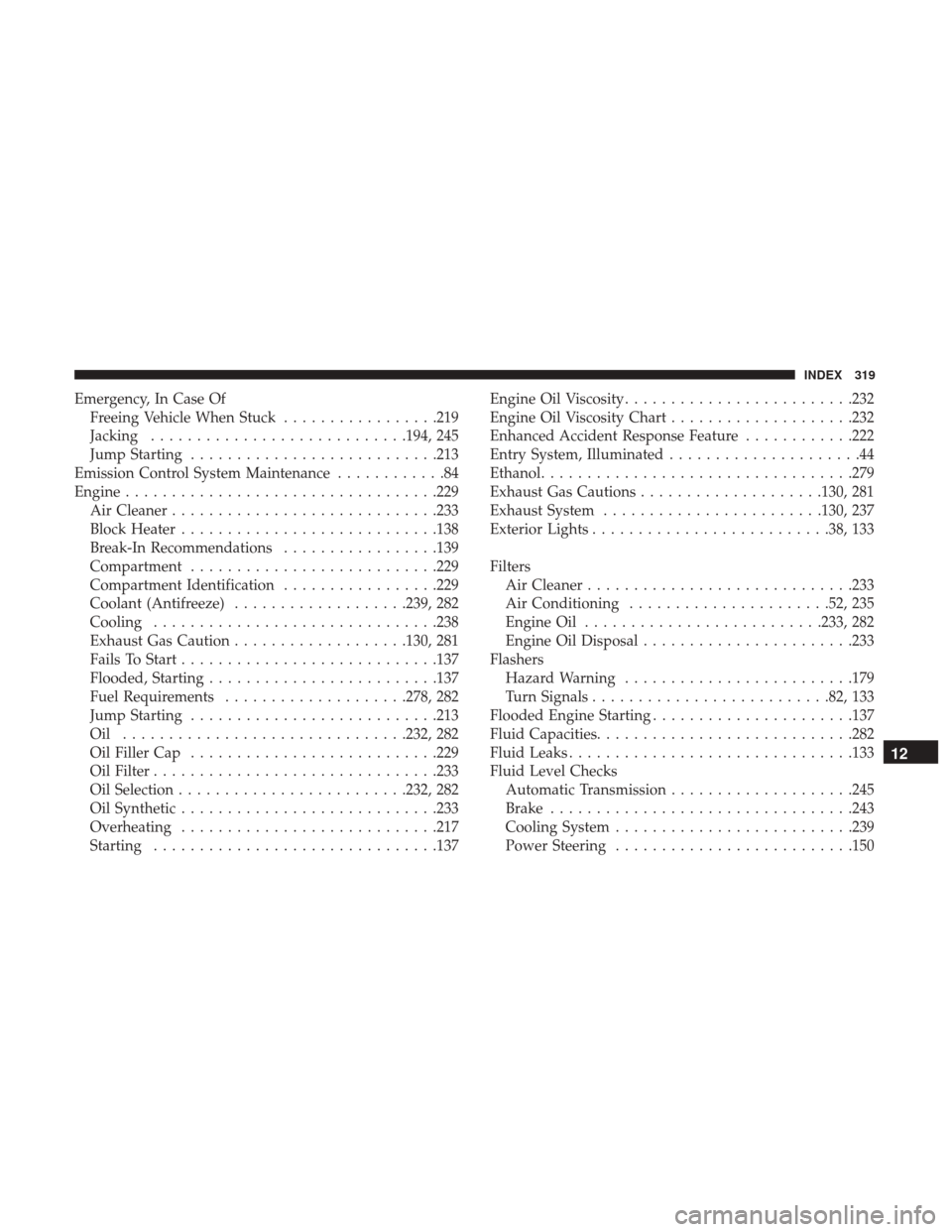
Emergency, In Case OfFreeing Vehicle When Stuck .................219
Jacking ........................... .194, 245
Jump Starting .......................... .213
Emission Control System Maintenance ............84
Engine ................................. .229
Air Cleaner ............................ .233
Block Heater ........................... .138
Break-In Recommendations .................139
Compartment .......................... .229
Compartment Identification .................229
Coolant (Antifreeze) ...................239, 282
Cooling .............................. .238
Exhaust Gas Caution ...................130, 281
Fails To Start ........................... .137
Flooded, Starting ........................ .137
Fuel Requirements ....................278, 282
Jump Starting .......................... .213
Oil .............................. .232, 282
Oil Filler Cap .......................... .229
Oil Filter .............................. .233
Oil Selection ........................ .232, 282
Oil Synthetic ........................... .233
Overheating ........................... .217
Starting .............................. .137Engine Oil Viscosity
........................ .232
Engine Oil Viscosity Chart ....................232
Enhanced Accident Response Feature ............222
Entry System, Illuminated .....................44
Ethanol ................................. .279
Exhaust Gas Cautions ....................130, 281
Exhaust System ....................... .130, 237
Exterior Lights ......................... .38, 133
Filters Air Cleaner ............................ .233
Air Conditioning ..................... .52, 235
Engine Oil ......................... .233,
282
Engine Oil Disposal ...................... .233
Flashers Hazard Warning ........................ .179
Turn Signals ......................... .82, 133
Flooded Engine Starting ..................... .137
Fluid Capacities ........................... .282
Fluid Leaks .............................. .133
Fluid Level Checks Automatic Transmission ....................245
Brake ................................ .243
Cooling System ......................... .239
Power Steering ......................... .150
12
INDEX 319
Page 324 of 332
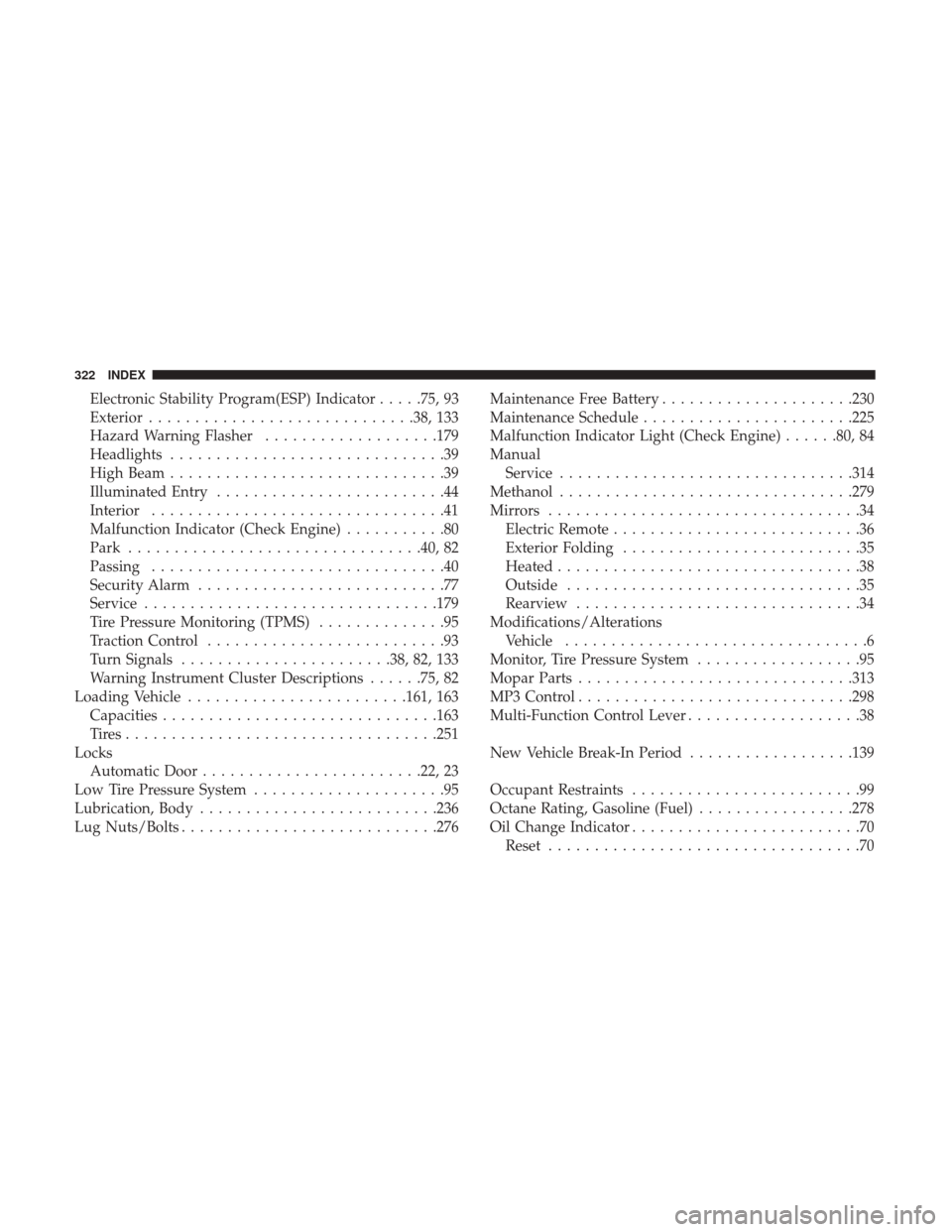
Electronic Stability Program(ESP) Indicator.....75, 93
Exterior ............................ .38, 133
Hazard Warning Flasher ...................179
Headlights ..............................39
High Beam ..............................39
Illuminated Entry .........................44
Interior ................................41
Malfunction Indicator (Check Engine) ...........80
Park ............................... .40, 82
Passing ................................40
Security Alarm ...........................77
Service ............................... .179
Tire Pressure Monitoring (TPMS) ..............95
Traction Control ..........................93
Turn Signals ...................... .38, 82, 133
Warning Instrument Cluster Descriptions ......75, 82
Loading Vehicle ....................... .161, 163
Capacities ............................. .163
Tires................................. .251
Locks Automatic Door ....................... .22, 23
Low Tire Pressure System .....................95
Lubrication, Body ......................... .236
Lug Nuts/Bolts ........................... .276Maintenance Free Battery
.....................230
Maintenance Schedule ...................... .225
Malfunction Indicator Light (Check Engine) ......80, 84
Manual Service ............................... .314
Methanol ............................... .279
Mirrors ..................................34
Electric Remote ...........................36
Exterior Folding ..........................35
Heated .................................38
Outside ................................35
Rearview ...............................34
Modifications/Alterations Vehicle .................................6
Monitor, Tire Pressure System ..................95
Mopar Parts ............................. .313
MP3 Control ............................. .298
Multi-Function Control Lever ...................38
New Vehicle Break-In Period ..................139
Occupant
Restraints .........................99
Octane Rating, Gasoline (Fuel) .................278
Oil Change Indicator .........................70
Reset ..................................70
322 INDEX
Page 331 of 332
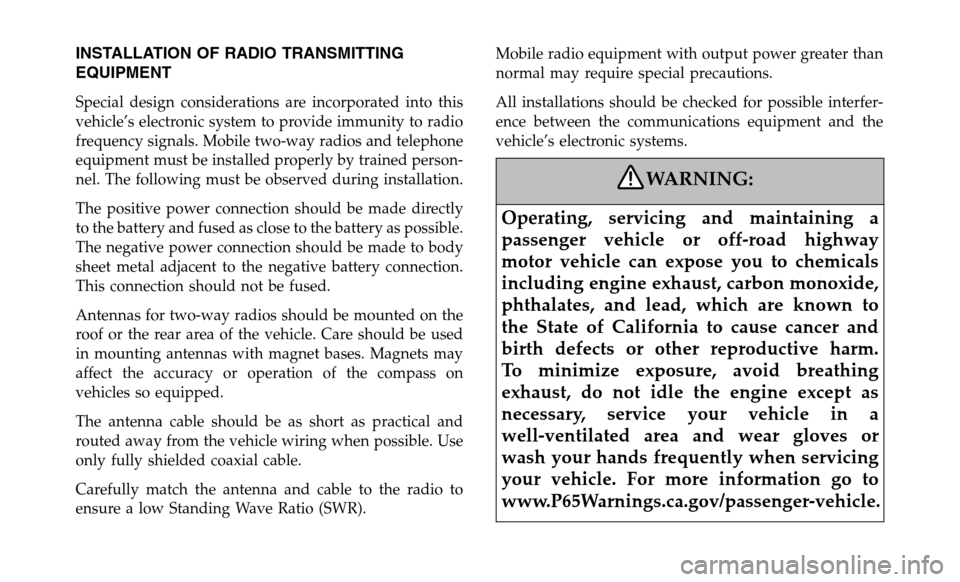
INSTALLATION OF RADIO TRANSMITTING
EQUIPMENT
Special design considerations are incorporated into this
vehicle’s electronic system to provide immunity to radio
frequency signals. Mobile two-way radios and telephone
equipment must be installed properly by trained person-
nel. The following must be observed during installation.
The positive power connection should be made directly
to the battery and fused as close to the battery as possible.
The negative power connection should be made to body
sheet metal adjacent to the negative battery connection.
This connection should not be fused.
Antennas for two-way radios should be mounted on the
roof or the rear area of the vehicle. Care should be used
in mounting antennas with magnet bases. Magnets may
affect the accuracy or operation of the compass on
vehicles so equipped.
The antenna cable should be as short as practical and
routed away from the vehicle wiring when possible. Use
only fully shielded coaxial cable.
Carefully match the antenna and cable to the radio to
ensure a low Standing Wave Ratio (SWR).Mobile radio equipment with output power greater than
normal may require special precautions.
All installations should be checked for possible interfer-
ence between the communications equipment and the
vehicle’s electronic systems.
WARNING:
Operating, servicing and maintaining a
passenger vehicle or off-road highway
motor vehicle can expose you to chemicals
including engine exhaust, carbon monoxide,
phthalates, and lead, which are known to
the State of California to cause cancer and
birth defects or other reproductive harm.
To minimize exposure, avoid breathing
exhaust, do not idle the engine except as
necessary, service your vehicle in a
well-ventilated area and wear gloves or
wash your hands frequently when servicing
your vehicle. For more information go to
www.P65Warnings.ca.gov/passenger-vehicle.